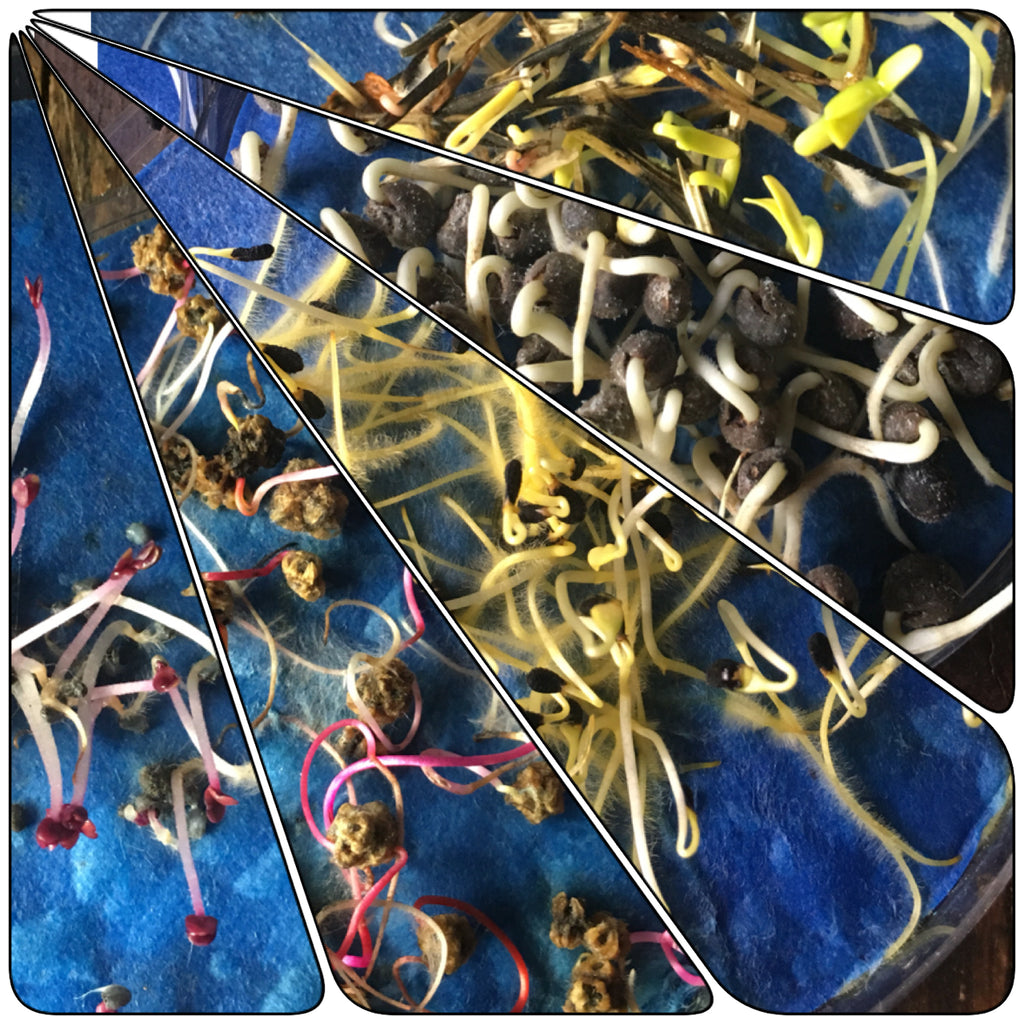Seed Planting Instructions
The following general rules apply to nearly all-vegetable seeds:
∞ Plant seeds about twice as deep as they are long, so if a bean is ½” long, plant it 1” deep.
∞ Plant in a fertile, well-drained soil mix. We make our own on our home farm from well-aged compost, sand (1:10 ratio with the compost), crushed eggshells and powdered kelp for minerals. Many good organic soil mixes are available at garden centers.
∞ Keep soil moist until germination – watering once or twice per day. Once seedlings emerge moisture is still important.
∞ Keep the seeds at the appropriate soil temperature for optimum germination. Please consult the chart below.
∞ Some crops should be direct sown in the garden, while others benefit from being started indoors or in a greenhouse, and others can be done either way. (See chart for specifics.)
∞ Keep a watchful eye for pests such as slugs, birds, cutworms and others that can eat young seedlings as soon as they emerge, often before you notice and then you assume that the seeds never sprouted. We will use spun-polyester row covers in instances when seedling predation is an issue.
∞ Keep in mind particularities about your microclimate or site that might influence optimal conditions. For instance, cucumber beetles are serious pests for us here, so we grow our melons as transplants and then set them in the field after June 1st and immediately cover with row covers. Normally we could simply direct seed them and water. We take similar precautions with cucumbers, summer squash and winter squash, although, we generally will direct seed them and then use row covers until the plants are about to flower and then remove them for the rest of the season as the plants are large enough to grow unimpeded by pests.
|
Crop Type |
Ideal soil temp. for germ. |
Typical days to germ. |
Ideal spacing of plants |
Spacing between rows |
Planting depth |
Transplant or direct sow |
|
Arugula |
60°-80° |
3-8 |
2-4” |
12-18” |
¼ - ½” |
Direct sow |
|
Basil |
60°-85° |
5-10 |
6-12” |
12-18” |
¼” |
Transplant |
|
Beans |
65°-85° |
3-8 |
4-6” |
18-24” |
½-1” |
Direct sow |
|
Beets |
55°-75° |
4-10 |
2-6” |
12-18” |
½” |
Direct sow |
|
Broccoli, Cabbage, Cauliflower, Brussels Sprouts |
55°-80° |
3-8 |
18-24” |
18-24” |
1/4-1/2” |
Transplant |
|
Carrots |
60°-75° |
5-14 |
1-3” |
12-24” |
¼-1/2” |
Direct sow |
|
Celery |
60°-75° |
5-21 |
12-18” |
18-24” |
¼-1/2” |
Transplant |
|
Chinese Cabbage |
55°-75° |
3-8 |
12-18” |
12-24” |
¼-1/2” |
Transplant or direct sow |
|
Collards, Kale |
55°-80° |
3-8 |
12-18” |
18-24” |
¼-1/2” |
Transplant |
|
Corn |
65°-90° |
3-10 |
6”-12” |
18-36” |
1” |
Direct sow |
|
Cucumber, Melons |
65°-90° |
3-7 |
12-36” |
36-48” |
½” |
Direct sow |
|
Eggplant, Pepper |
70°-85° |
4-10 |
18-24” |
18-24” |
¼- 1/2” |
Transplant |
|
Onions, Leeks |
50°-75° |
3-7 |
4-10” |
12-24” |
¼ - ½” |
Transplant |
|
Lettuce |
50°-70° |
3-7 |
12-18” |
12’18” |
¼” – ½” |
Transplant or direct sow |
|
Mustards |
50°-80° |
3-7 |
4-18” |
18” |
¼ - ½” |
Direct sow or transplant |
|
Peas |
55°-75° |
5-10 |
2-6” |
18-24” |
½” – 1” |
Direct sow |
|
Radish |
50°-80° |
3-10 |
2-4” |
12-18” |
½” |
Direct sow |
|
Spinach |
50°-75° |
5-10 |
2-6” |
12-18” |
½” |
Direct sow |
|
Summer Squash |
60°-80° |
5-10 |
18-30” |
36-60” |
½ - 1” |
Direct sow or transplant |
|
Tomato |
70°-85° |
5-10 |
18-36” |
36-60” |
¼ - ½” |
Transplant |
|
Winter Squash |
65°-80° |
5-10 |
24-48” |
36-60” |
½” – 1” |
Direct sow or trans. |


Cynni Bower
Thank you! Your seeds are the best I’ve ever planted! We are really enjoying the success of our plantings this season.